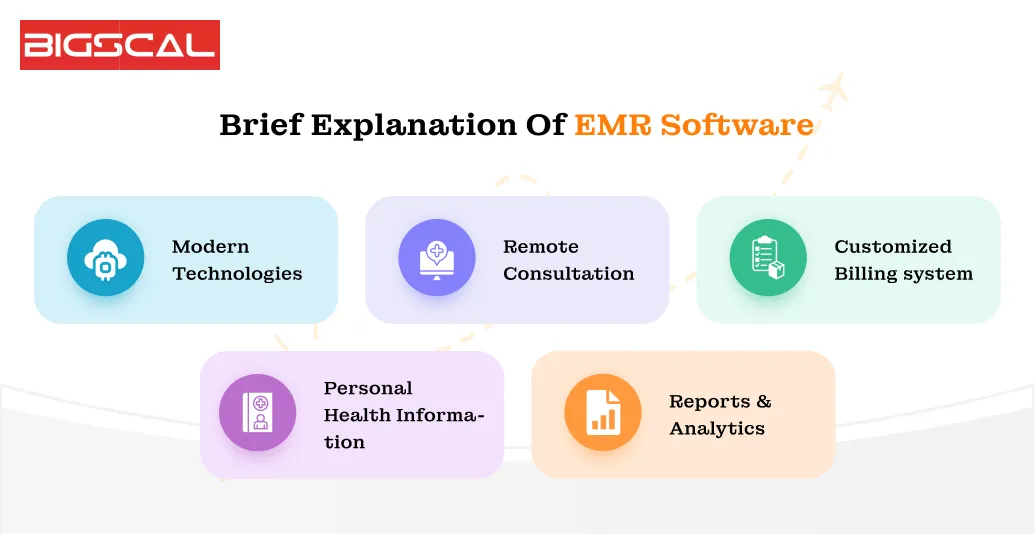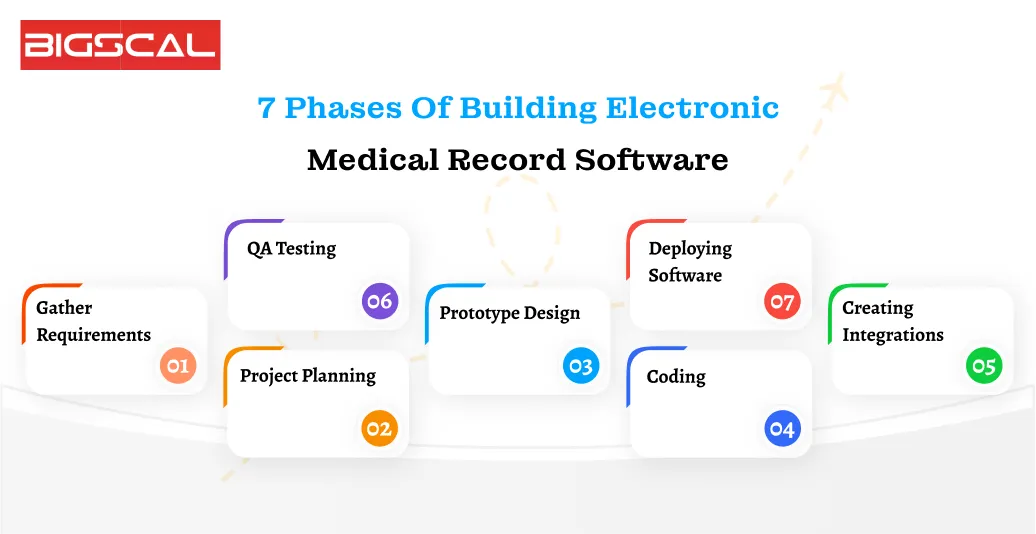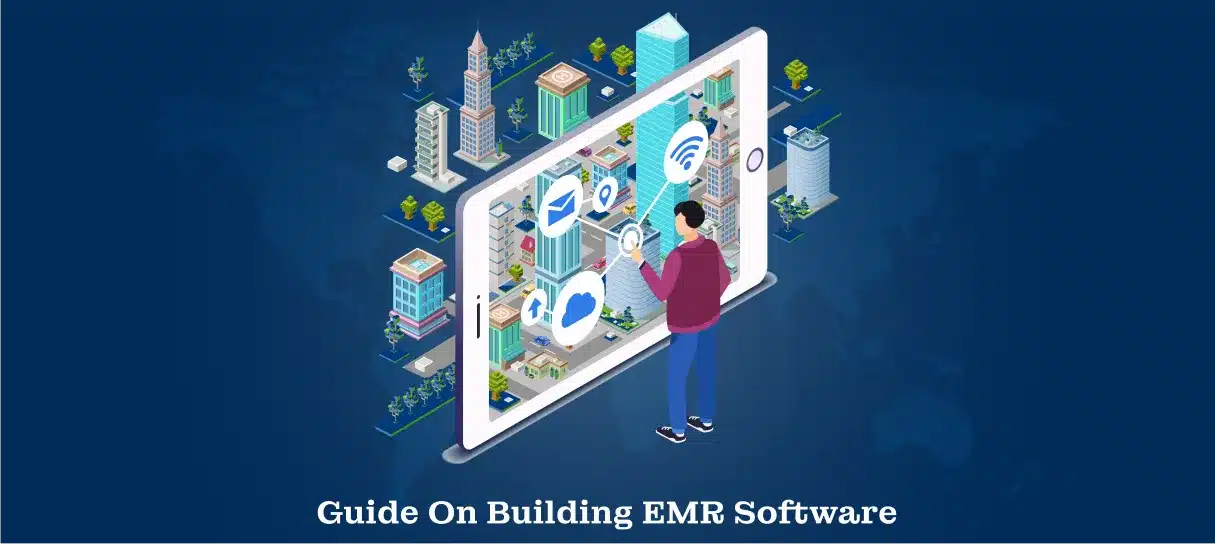Ultimate Guide on Building EMR Software
Quick Summary: Due to paper records, hospitals suffer a lot and lose lakhs of rupees. Creating EMR Software is the efficient way to help healthcare professionals and enhance their income. We uncover the steps of building electronic medical record software, you can build the best one for your clients by following the necessary phases.
Introduction
With the EMR software, the healthcare organization would not be dependent on the manual documentation, physical documents, and technical clinicians. There is a large sum of money spent in procuring files, big cabinets to store, and a printing seal for document authentication. We cannot recover the lost amount but can help you with the best EMR software solution, preventing future losses.
It comprises stages to develop the ultimate EMR software that decreases development errors and reduces confusion. Furthermore, the electronic medical record system initiative remodels the route of healthcare services and creates a healthier eco-system. Digitization gathers the healthcare documents and generates creative analytical reports for a definite prediction.
Crucial healthcare tool to supervise data, eliminate operational bottlenecks, analyze information, and follow healthcare compliance. Furthermore, the EMR system software reshapes all clinical facilities and streamlines to enhance decision making processes. Must-have functions that include patient record management system, medication management, insurance management, and front-end desk management.
Brief Explanation of EMR Software

The electronic medical record software quickly retains medical documents, safeguarding data, and transmitting clinical details. Moreover, it accesses any healthcare files through the patient ID number at whatever location. There are specific clinical rights given to patients like supervising their healthcare records, visualize real-time healthcare details. Following are the indispensable functions that must-have in the EMR software.
Modern Technologies
Nowadays, new and advanced inventions have been introduced in the EMR software. The latest one is AI Call assistant that easily connects with the electronic medical record system, facilitating operational services from task management to attending physician calls. Also, it translates complicated medical terminologies into simpler words, which is very helpful for patients.
Many documents can be circulated in the entire healthcare organization and can share outside hospitals with a single click. Furthermore, the EMR software decreases clinical errors and improves care quality. Securely transmit documents within or outside clinical departments by the following modern principles.
Remote Consultation
Virtual diagnosis would be the mandatory function in the busy world and receive consultation effortlessly. Cloud-based electronic medical record software helps to access any healthcare record from anyplace. Moreover, the healthcare EMR software creates a digital healthcare workflow that initiates from reserving physician time to pay amount.
With an unified EMR platform, patients cannot physically go anywhere for medical treatment. They receive health related services from their home such as communication with a physician, receive a prescription, create medication order, generate an invoice, receive slips, and pay to physicians. Therefore, the EMR system improves a remote facility, enlarges medical services, and increases revenue.
Customized Billing system
The healthcare organization creates hundreds of bills but there is a limit with the manual processing. Moreover, the EMR software extends the limit and now a clinician can create thousands of bills within a day. Occurring because of customized templates that streamline to organize elements as per needs.
The customization creates personalized invoices and adheres to billing protocols, leading to reduced invoicing errors and avoids penalties. Furthermore, it is advantageous for big hospitals and small clinics. Declines billing mistakes, records accurate costs, and streamline the accounting management.
Personal Health Information
Patients can record healthcare data as they want due to the gigantic database and extract from their personal accounts. Moreover, the data includes healthcare invoices, medical histories, test results, prescriptions, call recordings, real-time clinical reports, and payment details.
These records are safe at every phase whether the information, transmit to other healthcare departments, gather at a single place, and fetch from anywhere. Moreover, the EMR software follows HIPAA rules, reducing healthcare risks and lowering costs. Amend and remove information is easy.
Reports and Analytics
Generate tailor-reports after following the stepwise process such as gathering data, classifying it in better manner, and depicting custom reports in the visual format. Furthermore, the electronic medical record system showcases healthcare information and drafts analytical reports that eases to share and predicts details.
The EMR system software is absolutely necessary for reminding information and understanding the facts. Moreover, it showcases key information for comprehending overall healthcare situations. The report depicts current data and access information as per client requirements. Therefore, the managerial department can make decisions collaboratively and faster.
Which is the Best option : Pre-built or Custom EMR Software?
There are two choices in the market, healthcare organizations directly acquire hospital software and build custom EMR software to your own terms with the help of a developing company. Furthermore, purchasing a pre-built electronic medical records system software requires no strategy and planning.
However, it requires some basic steps such as accessing requirements, finding the best hospital software, taking a demo, picking the best one, deploying quickly, and training the healthcare team. Much effort and a clear strategy need, if you pick the custom electronic medical record software because there are various companies in the healthcare market.
Advice in complying several steps such as accessing the best companies, which majorly specialized to build healthcare software like Bigscal Technologies Pvt. Ltd. Communicate with team members and ask them to showcase the similar hospital product. Time-consuming and costly process. If hospitals want cost and time efficient software, go for pre-built EMR systems. On the other hand, if you need fully customized software, go for custom EMR systems.
7 Phases of Building Electronic Medical Record Software

The modern electronic medical record system software utilizes advanced technologies such as python, javascript, kotlin, angular, machine learning, deep learning, tensor flow, cloud fare, and apache. If you build software with a proper strategy and steps, there are very little chances of bugs and projects complete on time. Following are the seven vital steps of building electronic medical record software.
Gather Requirements
Understanding clients needs in their healthcare industry based on their goals and struggles. Sometimes the customer is unsure what he needs. In that case, software development companies should ask questions and create a requirement sheet.
Analyzing other similar software, add those features in the requirement sheet that thinks perfect as per needs. It includes HIPAA compliance, patient management system, reports, and etc.
Project Planning
After accumulating requirements of the healthcare software, deciding which technology has been used. Distributing the tasks among developers, QA, and designers. Furthermore, create planning for the project completion as per agile methodologies.
Decides how many developers are needed and how much time allocated for the healthcare project in a single day. Create a project estimation report based on the requirement and needed technology.
Prototype Design
Creates a rough design of healthcare software and how it is navigated. Then, design the final ones and share with clients. The design assists clients’ to understand the visualization of a software and eases for coders to code.
The project will execute further after approved by clients. Moreover, the design should be simple and look intuitive.
Coding
Developers built the healthcare website and application based on final software design, approved by customers. Moreover, handling the entire healthcare software project by the experienced project manager and code by talented team members.
The project work has been divided into front-end and back-end. Moreover, the software should be fully customized and functional.
Creating Integrations
The EMR software should integrate with healthcare systems such as RIS radiology information system), and pharmacy management system. Moreover, the LMS (lab management system) and personal health information (PHI) are mandatory integration. Running by developers very cautiously.
Each of the integrations has its own clinical tasks and requires seamless communication across the hospital.
QA Testing
Work completes through the sprint process, a portion of software complete and testing QA. If they identify the bug, the software developer again works on that. Moreover, the integrated system checks carefully , whether it runs smoothly or not, often using QA testing tools to ensure thorough validation.
Before sharing with clients, first the code should be tested by QA. Also, software testing is an iterable process till accomplishing goals.
Deploying Software
After completing the sprint process, the finished healthcare software checks by QA team members before deploying to the healthcare industry. Furthermore, the final software checks by the customer and finally launches the EMR software.
Explaining the healthcare software to team members and training to some of the individuals.
Conclusion
The hospital scheduling software showcases all appointment histories and associated activities within an unified platform. Furthermore, the role of AI-driven hospital scheduling software, preserve documentation time, digitize appointment records, reduce no-shows, centralize data, and improve client retention rate. Additionally, the functions are data integration, automated reminders, administrative tasks management system, patient appointment system, and apportion resources to medical departments. Overall, it improves turnaround time.
FAQ
What are the prominent steps for building EMR software?
Building electronic medical record software is not tough or not that easy. It initiates through gathering technical and a functional requirement from the clients and competitive software. Furthermore, the prominent steps for building electronic medical record software include gathering requirements, project planning, prototype design, coding, integrations, QA testing, and deploying software.
Which one to choose : pre-built or custom EMR software?
Pre-built and custom EMR software has its own merits, customers select one of them as per their needs. Moreover, the pre-built electronic medical record system is ready-to-use and power to customize at limit. On the other hand, custom EMR software is fully customized but takes too much time in development as compared to the pre-built EMR software.
Are electronic medical records safe to record?
Absolutely, electronic medical records are safe to record. It has a big capability to retain hospital information and modify it whenever needed. Furthermore, it is not complex to understand but even more intuitive. Not only limited to archives, performing countless healthcare tasks.
Which is the best tool to replace paper in the healthcare industry?
The electronic medical record system is the leading and efficient tool to replace paper in the healthcare industry. Furthermore, it keeps the big clinical documents, medical reports, pay slips, inventory reports, and radiology reports. Not only keeping but also creating it within some time.
Which is the leading way to administer healthcare expenses?
The leading way to administer healthcare expenses is to employ electronic medical record software. Moreover, it declines complexities in the hospital system and administering expenses. Archiving pay slips and collects other financial statements, easy to draft and reduces clinical errors.
What are the advantages of the pre-built hospital software?
The pre-built EMR software is the ready-to-use platform but assists to make some modifications as per their requirements. Furthermore, the pre-built electronic medical record software preserves costs, saves time, and takes less time in deployment. It is leading for the larger healthcare organization and small clinics.
Is project planning necessary in building healthcare software?
Yes, project planning is necessary in building healthcare software. This step clears the assignment tasks to the front-end developers, back-end developers, QA, and designers. Moreover, it includes the project estimation as per the tasks requirement and how the payment is made by the client.
What are the benefits of the customized EMR system?
The customized electronic medical record system adds the functionalities as clients’ wants and customers have the full control to create the software design as per their requirements. It is not there in the pre-built EMR software. The functionalities can be changed as per evolving requirements.
What are the capabilities of the modern electronic medical record system?
The modern electronic medical record system schedules physician tasks, controls appointments activities, creates the registration process, analyzes information, and answers calls to multiple clients. Furthermore, the top EMR software provider anticipates future inventory demand, sales forecast, revenue earning.
Which is the top company for developing EMR software?
Bigscal Technologies Pvt. Ltd. is the top company for developing electronic medical record software. This company has top front-end developers, designers, back-end developers, and designers. Furthermore, it utilizes sprint processes in the project completion and swiftly launching the EMR software.





